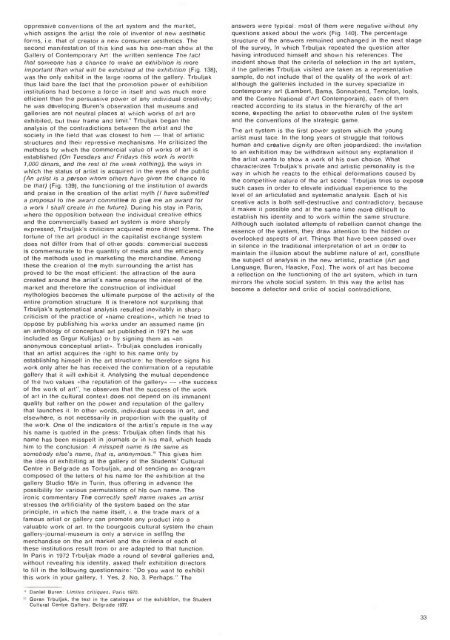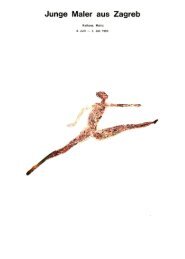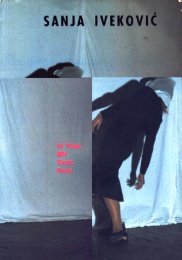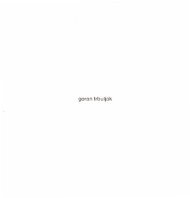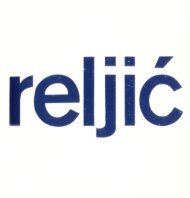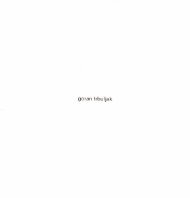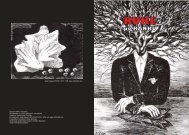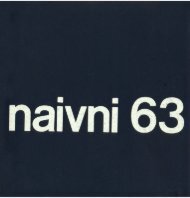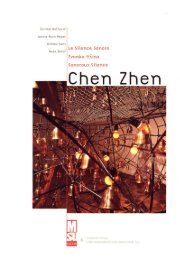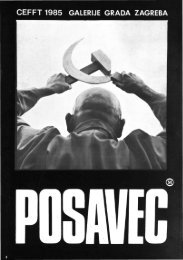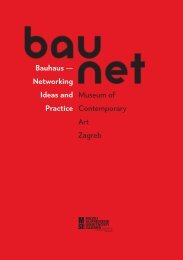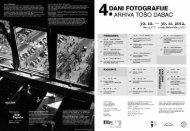The New Art Practice in Yugoslavia, 1966-1978
The New Art Practice in Yugoslavia, 1966-1978
The New Art Practice in Yugoslavia, 1966-1978
- TAGS
- practice
- yugoslavia
- www.msu.hr
Create successful ePaper yourself
Turn your PDF publications into a flip-book with our unique Google optimized e-Paper software.
oppressive conventions of the art system and the market,<br />
which assigns the artist the role of <strong>in</strong>ventor of new aesthetic<br />
forms, i.e. that of creator a new consumer aesthetics. <strong>The</strong><br />
second manifestation of this k<strong>in</strong>d was his one-man show at the<br />
Gallery of Contemporary <strong>Art</strong>: the written sentence <strong>The</strong> fact<br />
that someone has a chance to make an exhibition is more<br />
important than what will be exhibited at the exhibition (Fig. 138),<br />
was the only exhibit <strong>in</strong> the large rooms of the gallery. Trbuljak<br />
thus laid bare the fact that the promotion power of exhibition<br />
<strong>in</strong>stitutions had become a force <strong>in</strong> itself and was much more<br />
efficient than the persuasive power of any <strong>in</strong>dividual creativity;<br />
he was develop<strong>in</strong>g Buren's observation that museums and<br />
galleries are not neutral places at which works of art are<br />
exhibited, but their frame and limit.' Trbuljak began the<br />
analysis of the contradictions between the artist and the<br />
society <strong>in</strong> the field that was closest to him that of artistic<br />
structures and their repressive mechanisms. He criticized the<br />
methods by which the commercial value of works of art is<br />
established (On Tuesdays and Fridays this work is worth<br />
1,000 d<strong>in</strong>ars, and the rest of the week noth<strong>in</strong>g), the ways <strong>in</strong><br />
which the status of artist is acquired <strong>in</strong> the eyes of the public<br />
(An artist is a person whom others have given the chance to<br />
be that) (Fig. 139), the function<strong>in</strong>g of the <strong>in</strong>stitution of awards<br />
and praise <strong>in</strong> the creation of the artist myth (/ have submitted<br />
a proposal to the award committee to give me an award for<br />
a work I shall create <strong>in</strong> the future). Dur<strong>in</strong>g his stay <strong>in</strong> Paris,<br />
where the opposition between the <strong>in</strong>dividual creative ethics<br />
and the commercially based art system is more sharply<br />
expressed, Trbuljak's criticism acquired more direct forms. <strong>The</strong><br />
fortune of the art product <strong>in</strong> the capitalist exchange system<br />
does not differ from that of other goods: commercial success<br />
is commensurate to the quantity of media and the efficiency<br />
of the methods used <strong>in</strong> market<strong>in</strong>g the merchandise. Among<br />
these the creation of the myth surround<strong>in</strong>g the artist has<br />
proved to be the most efficient: the attraction of the aura<br />
created around the artist's name ensures the <strong>in</strong>terest of the<br />
market and therefore the construction of <strong>in</strong>dividual<br />
mythologies becomes the ultimate purpose of the activity of the<br />
entire promotion structure. It is therefore not surpris<strong>in</strong>g that<br />
Trbuljak's systematical analysis resulted <strong>in</strong>evitably <strong>in</strong> sharp<br />
criticism of the practice of .name creation», which he tried to<br />
oppose by publish<strong>in</strong>g his works under an assumed name (<strong>in</strong><br />
an anthology of conceptual art published <strong>in</strong> 1971 he was<br />
<strong>in</strong>cluded as Grgur Kulijas) or by sign<strong>in</strong>g them as an<br />
anonymous conceptual artist». Trbuljak concludes ironically<br />
that an artist acquires the right to his name only by<br />
establish<strong>in</strong>g himself <strong>in</strong> the art structure: he therefore signs his<br />
work only after he has received the confirmation of a reputable<br />
gallery that it will exhibit it Analys<strong>in</strong>g the mutual dependence<br />
of the two values «the reputation of the gallery» «the success<br />
of the work of art", he observes that the success of the work<br />
of art <strong>in</strong> the cultural context does not depend on its immanent<br />
quality but rather on the power and reputation of the gallery<br />
that launches it. In other words, <strong>in</strong>dividual success <strong>in</strong> art, and<br />
elsewhere, is not necessarily <strong>in</strong> proportion with the quality of<br />
the work. One of the <strong>in</strong>dicators of the artist's repute is the way<br />
his name is quoted <strong>in</strong> the press: Trbuljak often f<strong>in</strong>ds that his<br />
name has been misspelt <strong>in</strong> journals or <strong>in</strong> his mail, which leads<br />
him to the conclusion: A misspelt name is the same as<br />
somebody else's name, that is. anonymous."' This gives him<br />
the idea of exhibit<strong>in</strong>g at the gallery of the Students' Cultural<br />
Centre <strong>in</strong> Belgrade as Torbuljak, and of send<strong>in</strong>g an anagram<br />
composed of the letters of his name for the exhibition at the<br />
gallery Studio 16 e <strong>in</strong> Tur<strong>in</strong>, thus offer<strong>in</strong>g <strong>in</strong> advance the<br />
possibility for various permutations of his own name. <strong>The</strong><br />
ironic commentary <strong>The</strong> correctly spelt name makes an artist<br />
stresses the artificiality of the system based on the star<br />
pr<strong>in</strong>ciple, <strong>in</strong> which the name itself, i. e. the trade mark of a<br />
famous artist or gallery can promote any product <strong>in</strong>to a<br />
valuable work of art. In the bourgeois cultural system the cha<strong>in</strong><br />
gallery-journal-museum is only a service <strong>in</strong> sell<strong>in</strong>g the<br />
merchandise on the art market and the criteria of each of<br />
these <strong>in</strong>stitutions result from or are adapted to that function.<br />
In Paris <strong>in</strong> 1972 Trbuljak made a round of several galleries and,<br />
without reveal<strong>in</strong>g his identity, asked their exhibition directors<br />
to fill <strong>in</strong> the follow<strong>in</strong>g questionnaire: "Do you want to exhibit<br />
this work <strong>in</strong> your gallery, 1. Yes, 2. No, 3. Perhaps." <strong>The</strong><br />
9 Daniel Buren: Limites critiques, Paris 1970.<br />
0 Goran Trbuljak, the text <strong>in</strong> the catalogue of the exhibition. the Student<br />
Cultural Centre Gallery. Belgrade 1977.<br />
answers were typical: most of them were negative without any<br />
questions asked about the work (Fig. 140). <strong>The</strong> percentage<br />
structure of the answers rema<strong>in</strong>ed unchanged <strong>in</strong> the next stage<br />
of the survey, <strong>in</strong> which Trbuljak repeated the question after<br />
hav<strong>in</strong>g <strong>in</strong>troduced himself and shown his references. <strong>The</strong><br />
<strong>in</strong>cident shows that the criteria of selection <strong>in</strong> the art system,<br />
if the galleries Trbuljak visited are taken as a representative<br />
sample, do not <strong>in</strong>clude that of the quality of the work of art:<br />
although the galleries <strong>in</strong>cluded <strong>in</strong> the survey specialize <strong>in</strong><br />
contemporary art (Lambert, Bama, Sonnabend, TempIon, loals,<br />
and the Centre National d'<strong>Art</strong> Contempora<strong>in</strong>), each of them<br />
reacted accord<strong>in</strong>g to its status <strong>in</strong> the hierarchy of the art<br />
scene, expect<strong>in</strong>g the artist to observethe rules of the system<br />
and the conventions of the strategic game.<br />
<strong>The</strong> art system is the first power system which the young<br />
artist must face. In the long years of struggle that follows<br />
human and creative dignity are often jeopardized: the <strong>in</strong>vitation<br />
to an exhibition may be withdrawn without any explanation if<br />
the artist wants to show a work of his own choice. What<br />
characterizes Trbuljak's private and artistic personality is the<br />
way <strong>in</strong> which he reacts to the ethical deformations caused by<br />
the competitive nature of the art scene: Trbuljak tries to expose<br />
such cases <strong>in</strong> order to elevate <strong>in</strong>dividual experience to the<br />
level of an articulated and systematic analysis. Each of his<br />
creative acts is both self-destructive and contradictory, because<br />
it makes it possible and at the same time more difficult to<br />
establish his identity and to work with<strong>in</strong> the same structure.<br />
Although such isolated attempts of rebellion cannot change the<br />
essence of the system, they draw attention to the hidden or<br />
overlooked aspects of art. Th<strong>in</strong>gs that have been passed over<br />
<strong>in</strong> silence <strong>in</strong> the traditional <strong>in</strong>terpretation of art <strong>in</strong> order to<br />
ma<strong>in</strong>ta<strong>in</strong> the illusion about the sublime nature of art, constitute<br />
the subject of analysis <strong>in</strong> the new artistic, practice (<strong>Art</strong> and<br />
Language, Buren, Haacke, Fox). <strong>The</strong> work of art has become<br />
a reflection on the function<strong>in</strong>g of the art system, which <strong>in</strong> turn<br />
mirrors the whole social system. In this way the artist has<br />
become a detector and critic of social contradictions.<br />
33


